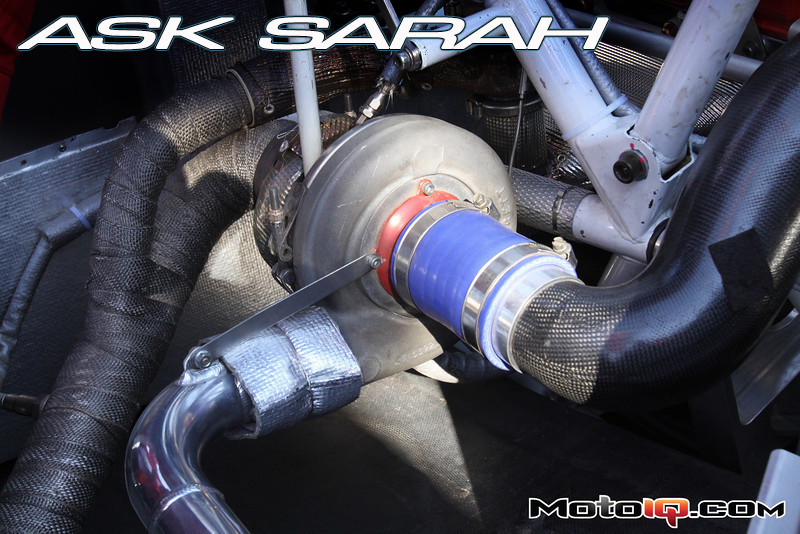I keep hearing that blankets, wraps and ceramic coatings overheat turbos. Retaining heat in exhaust manifolds help with scavenging and lower under hood temperatures. Are our forum “self proclaimed engineers” just scaring me way from having a super awesome cool engine bay and efficient turbo setup? And what about using blankets and ceramic coatings together?
-Miguel Perez-Montoya
 |
Walker Wilkinson's S13 says nighty night with heat blankets and thermal wrap. It's a necessary insurance but cosmetically could use some retouching. You still need to keep oil leaks from saturating a turbo blanket or it flares up as easy as a cigarette in a high school locker room. |
I love super awesome cool engine bays too so wrap it up! Obvious enough is anything fra-gil-e’ that is closely located to the turbo, exhaust manifold, and downpipe – all which will be emitting oodles of heat – should be wrapped with heat protective tape or a shield to keep them from burning up or sending your project up in flames. My personal experience was a fan wire that got a little too close to my snail and self destructed, almost taking my $$$ JDM engine with it. TG for water temp gauges!
Turbos generate a lot of heat and heat is a notorious power robber which makes reducing the temperature on the intake side better for power – colder air will provide a denser intake charge which is better for combustion. It will also help to keep wear and tear down on rubber and plastic components in the engine bay.
A coated exhaust header will radiate up to half as much heat into the engine bay as one left uncoated. Coatings like Swain Tech and pipe wraps and heat control products from DEI or Thermotec can handle this. Swain Tech’s White Lightning ceramic (ceramic is known for being wear resistant and heat insulating) coating is about 0.015” thick, 5-8 times as thick as typical cosmetic coatings. DEI offers header wraps (in 3 colors – tan, titanium, and black), heat barriers, and wire protection. Thermotec offers heat shields, wire sleeves, thermo flex protection for over hoses and wires, turbo covers, insulating wraps and manifold blankets, Hi Heat coating spray, and a thermo shield that uses an adhesive backed woven silica heat shield with aluminum finish, the whole enchilada. These products come in a variety of sizes and colors and are capable of many different temperature ratings from 500 degrees Farenheit to 2000 degrees Farenheit.
 |
When you've got the cash to throw one of these turbos on your engine, it only makes sense to use inconel heat shields to create a thermal barrier between radiant heat and other uber expensive engine components. |
ADDED BONUS- As you also pointed out, keeping heat contained in the exhaust manifold and turbine housing will also keep the exhaust gas velocity high which for turbo cars, helps spool the turbo and cash in on that scavenging effect. It can even be helpful in naturally aspirated engines, where a good velocity exhaust stream keeps the exhaust gas flow high and develops a vacuum behind the closed exhaust valve that helps with scavenging when the exhaust valve opens on the next cycle.
 |
MIQ's Project Supra is wrapped up like a Christmas present. Swain Tech's White Lightning thermal coating was applied to the exhaust manifold and housing while the 6 runner exhaust manifold was also meticulously wrapped in Thermotec's header wrap and Hi Heat coating spray. The coating spray protects the wrap from abrasions, corrosion, and damaging liquid spills. On the intake side, Thermotec's woven silica, aluminized heat barrier will withstand radiant heat from the engine block. Ready for business! |
It's fine to use a ceramic coating with any of the wraps concurrently. Wraps can hold in moisture and deteriorate over time so if you use a wrap on an untreated (uncoated) component, be careful wrapping it as any moisture trapped could lead to corrosion just like moisture on any bare metal could. A ceramic coating can actually help prevent corrosion from occuring. Any flaking or corrosion can also be caused by not using the correct temperature rating for the range of heat you'll be experiencing or using a company that doesn't prep well before coating. Wrap is cheap though – you can inspect it periodically just to make sure you're not experiencing any issues.
 |
Project G20's downpipe is wrapped in DEI's exhaust wrap. |



